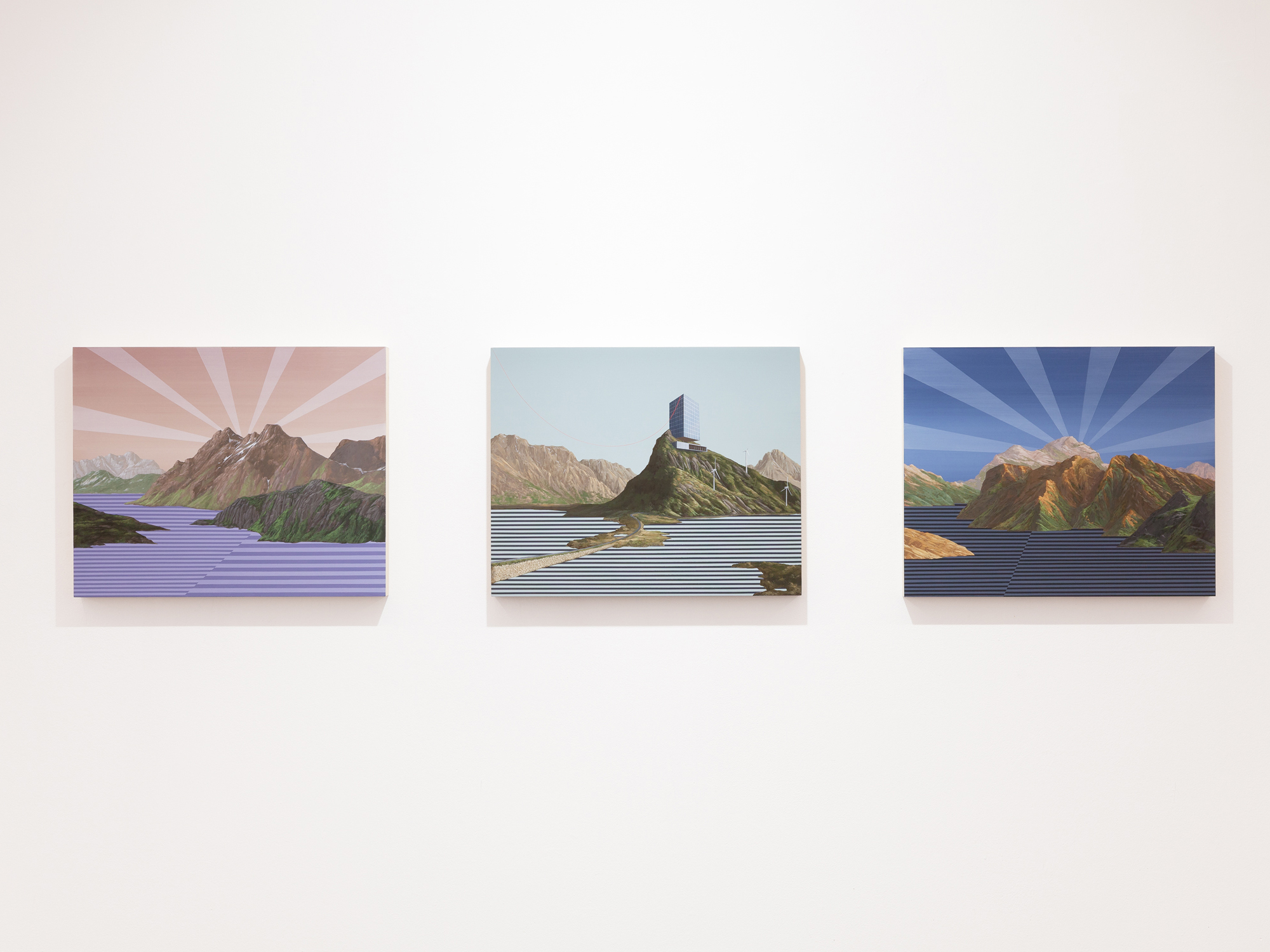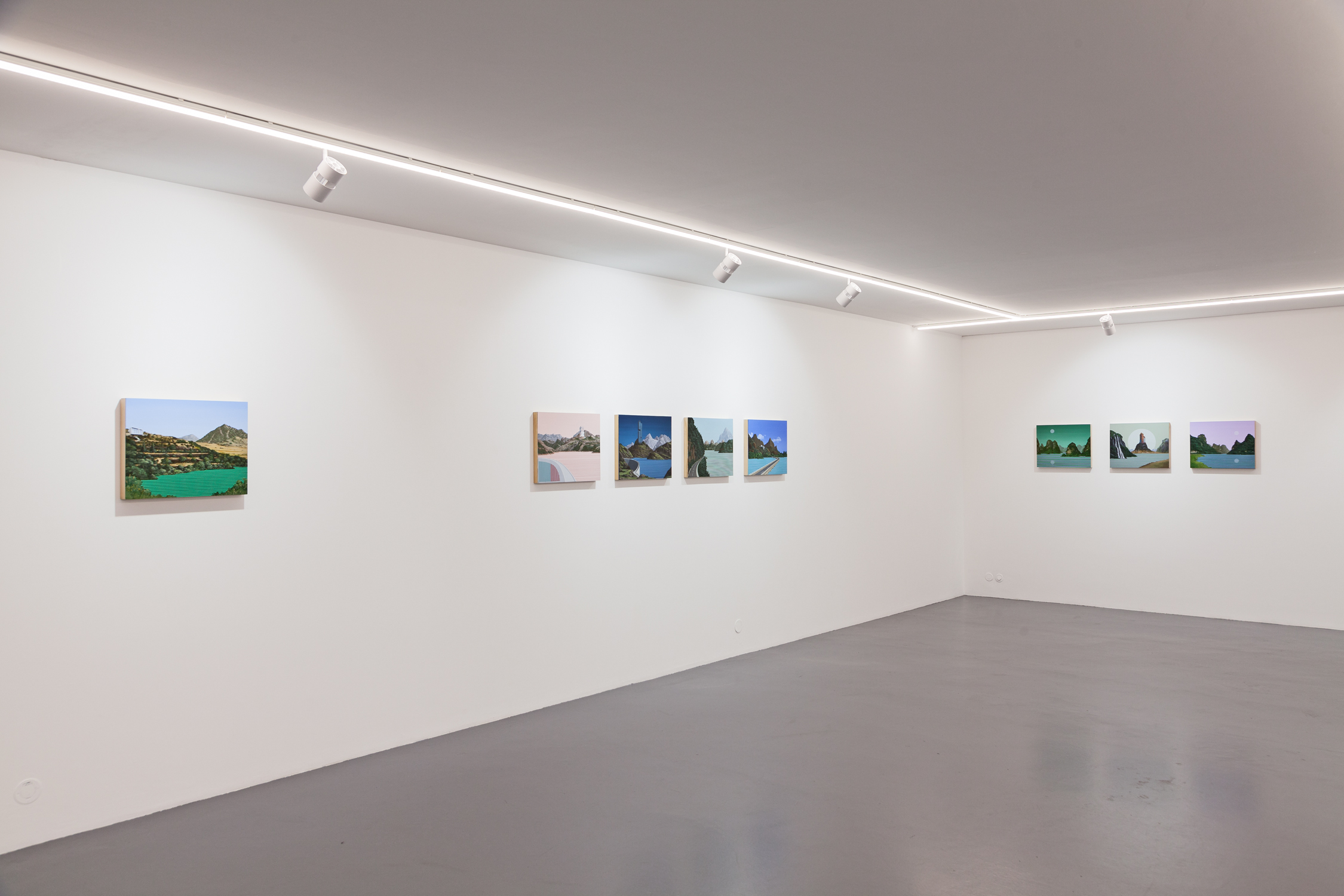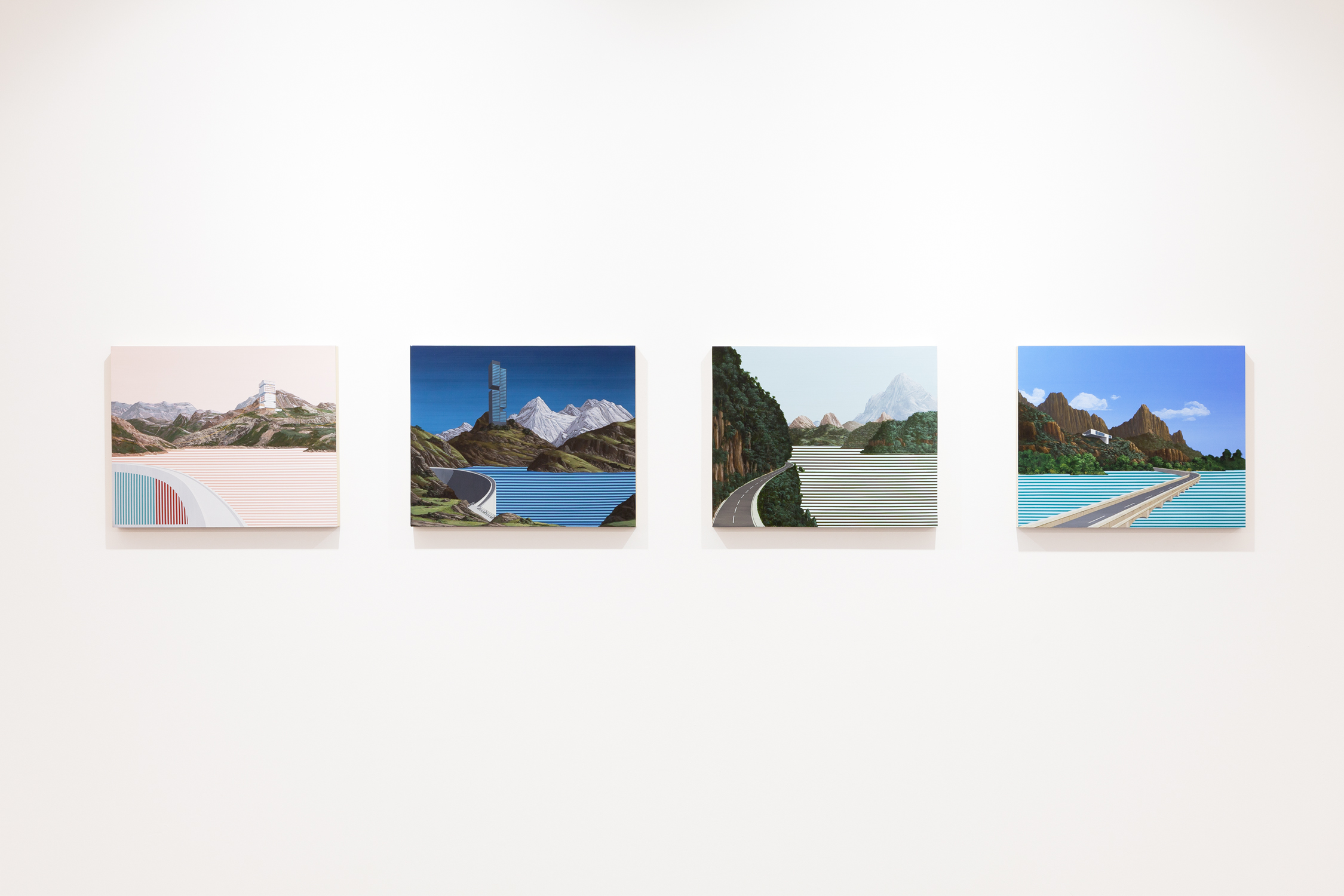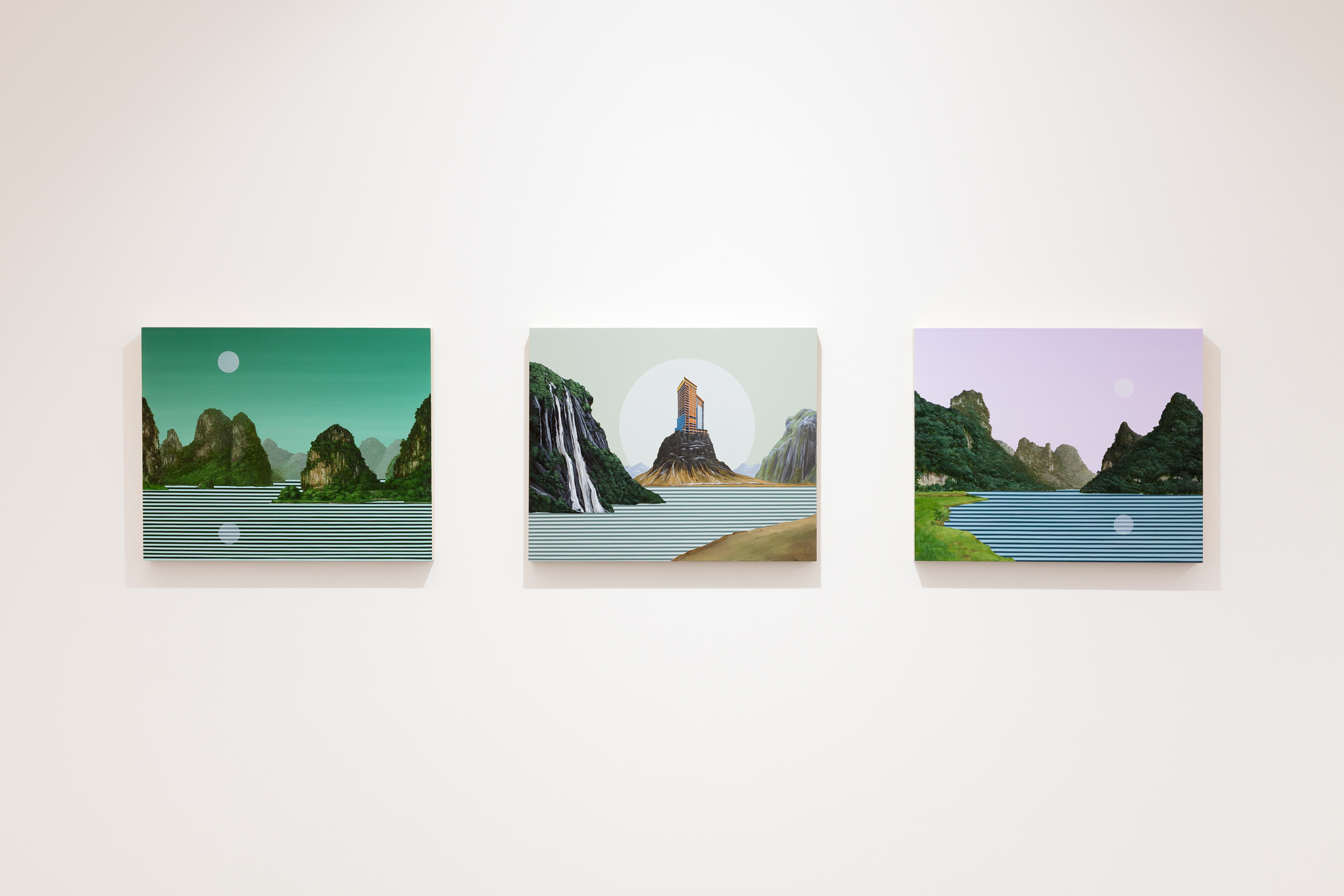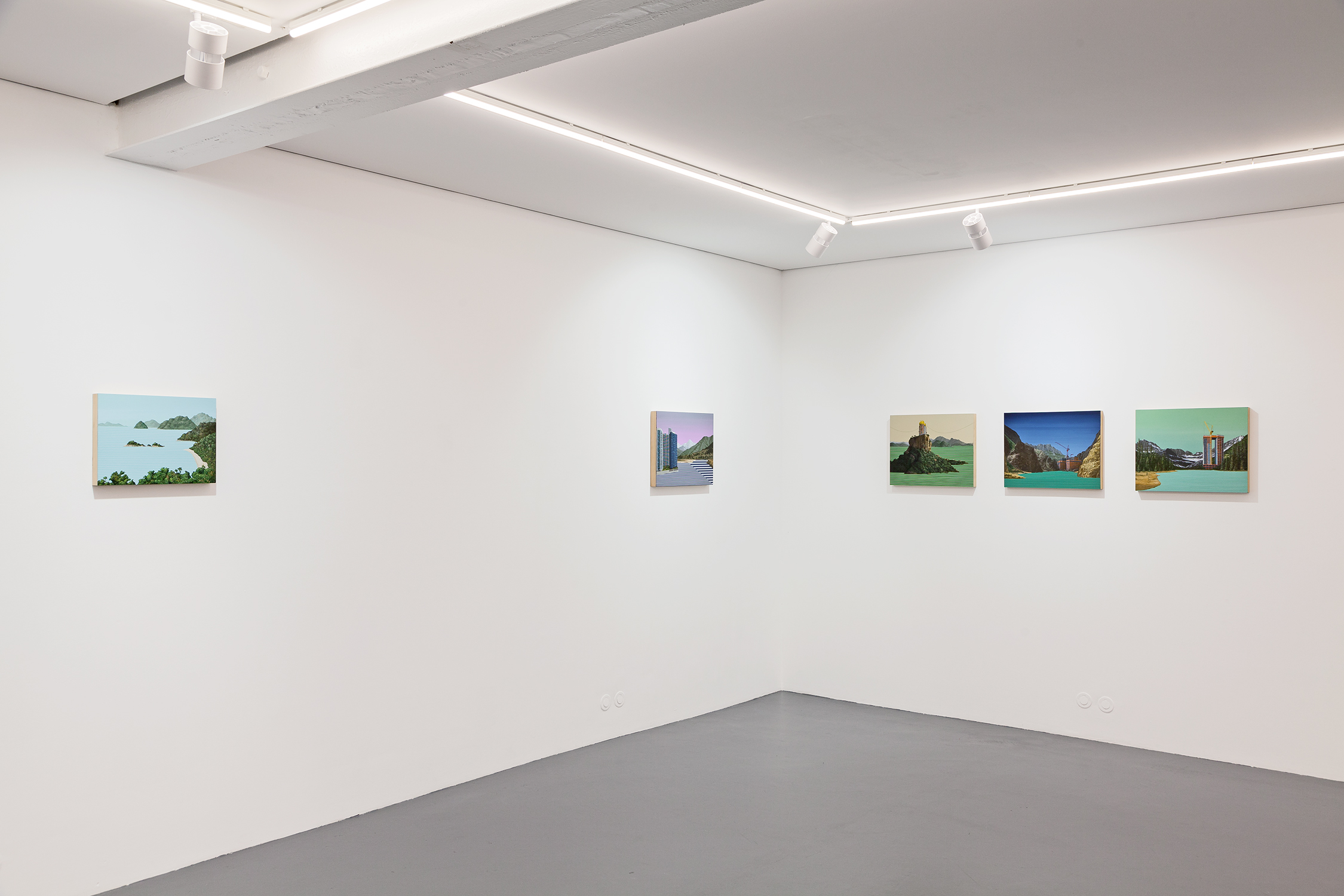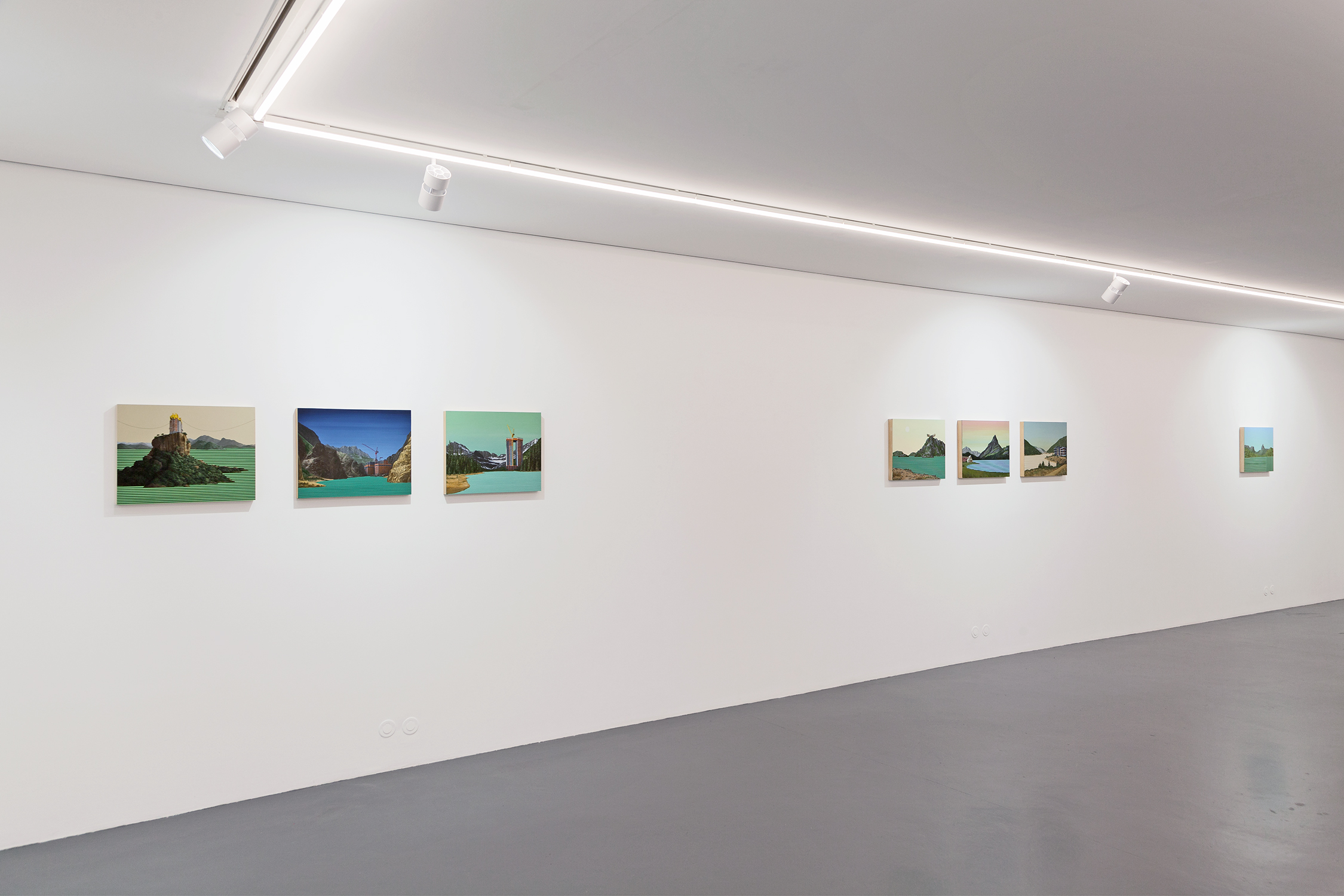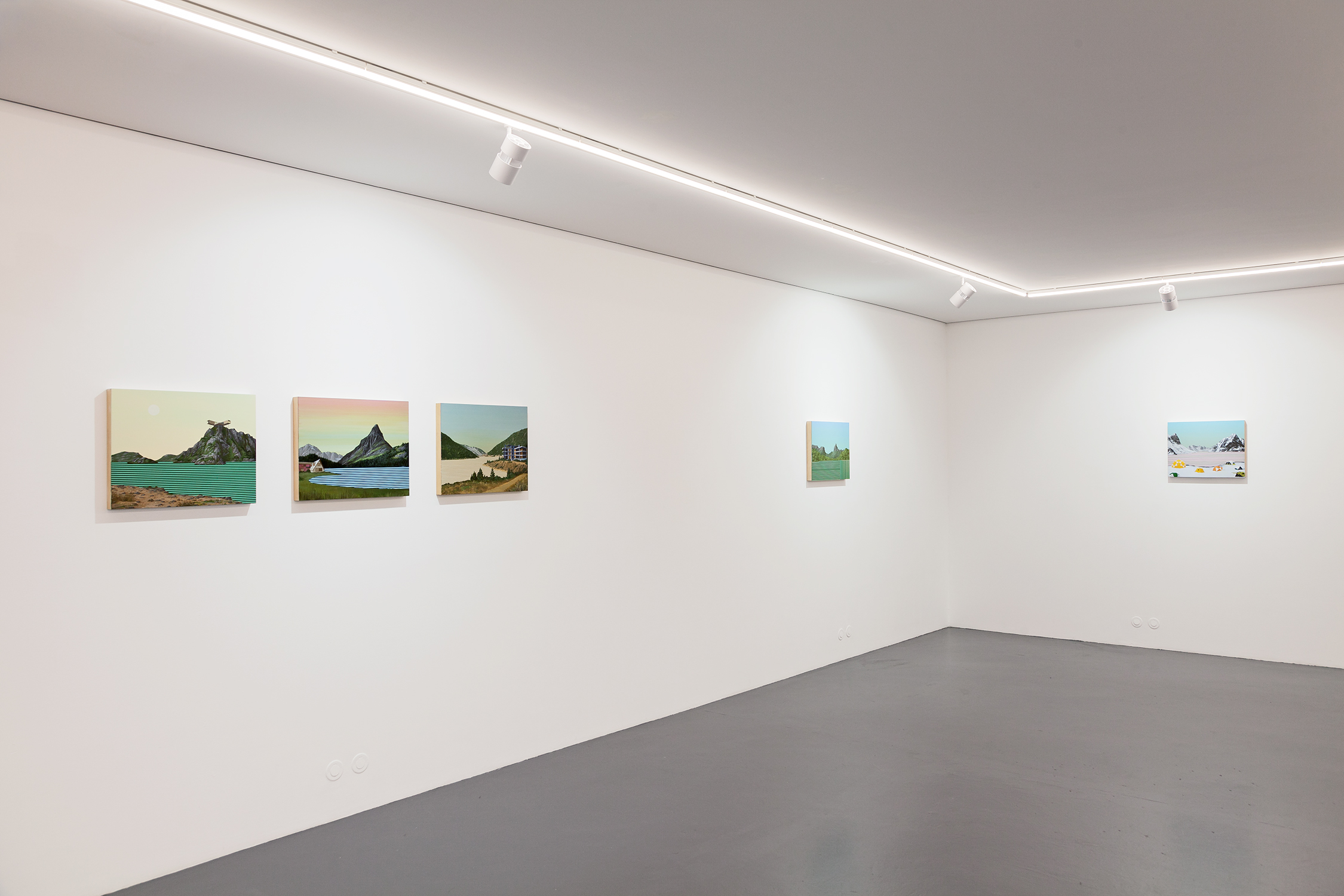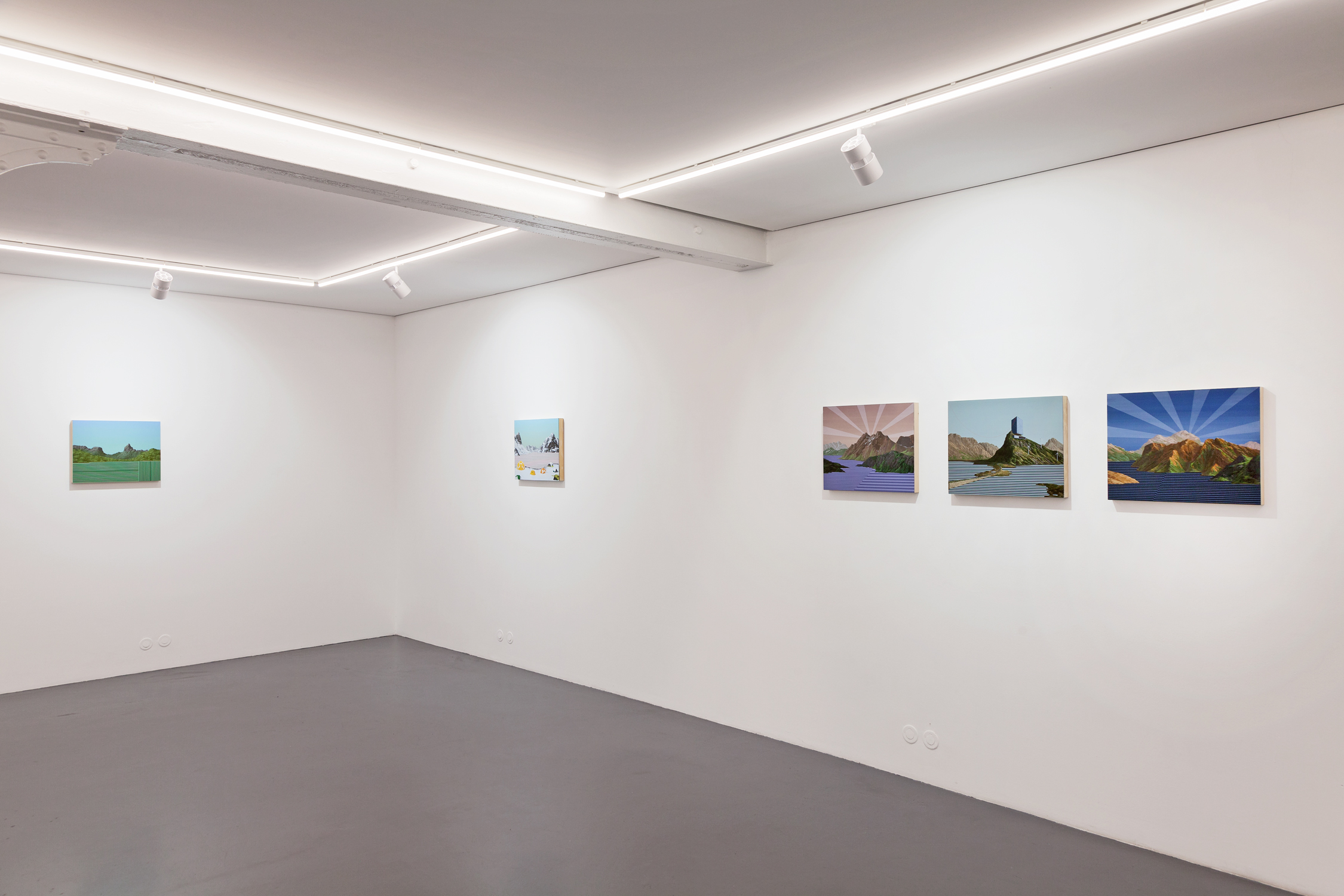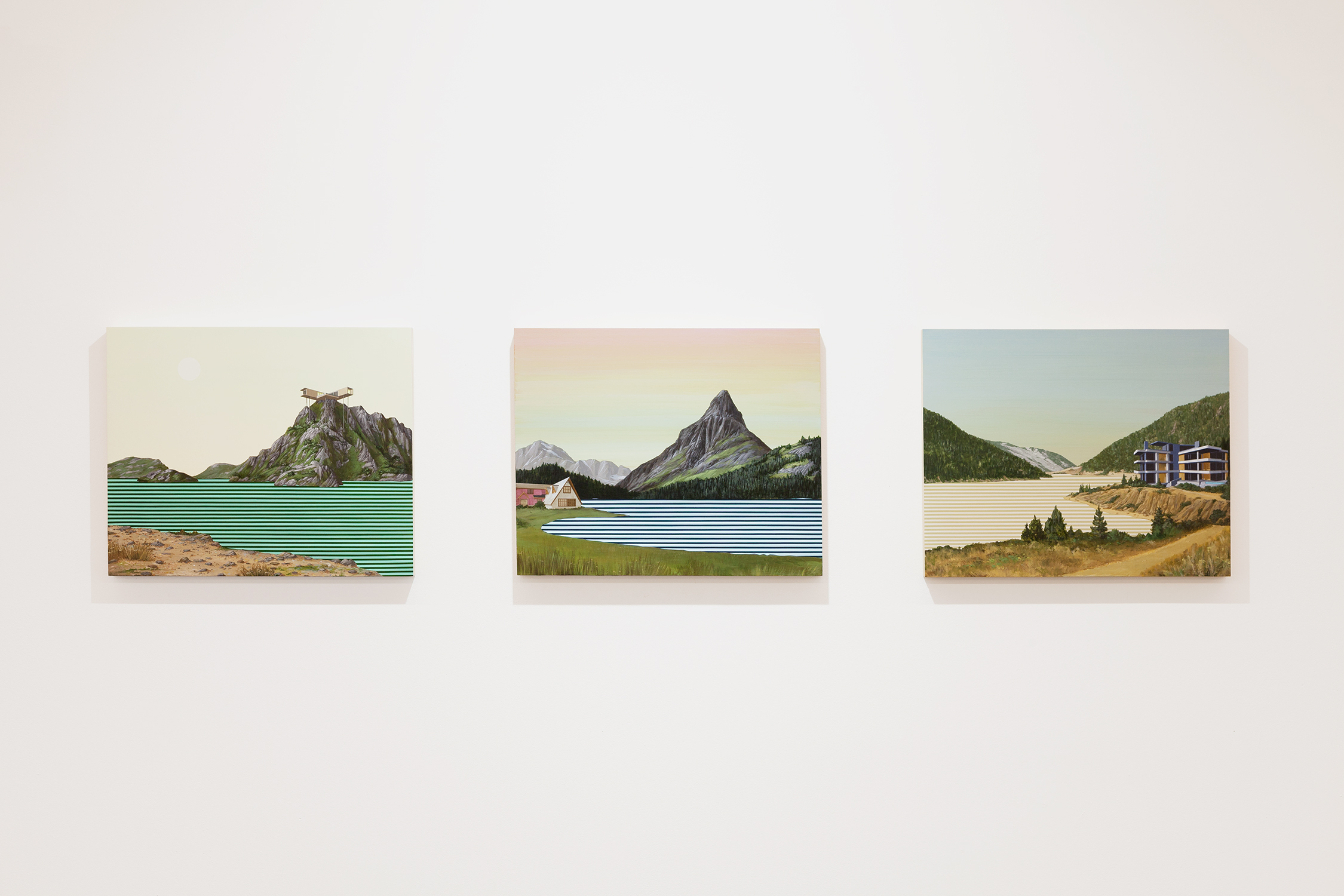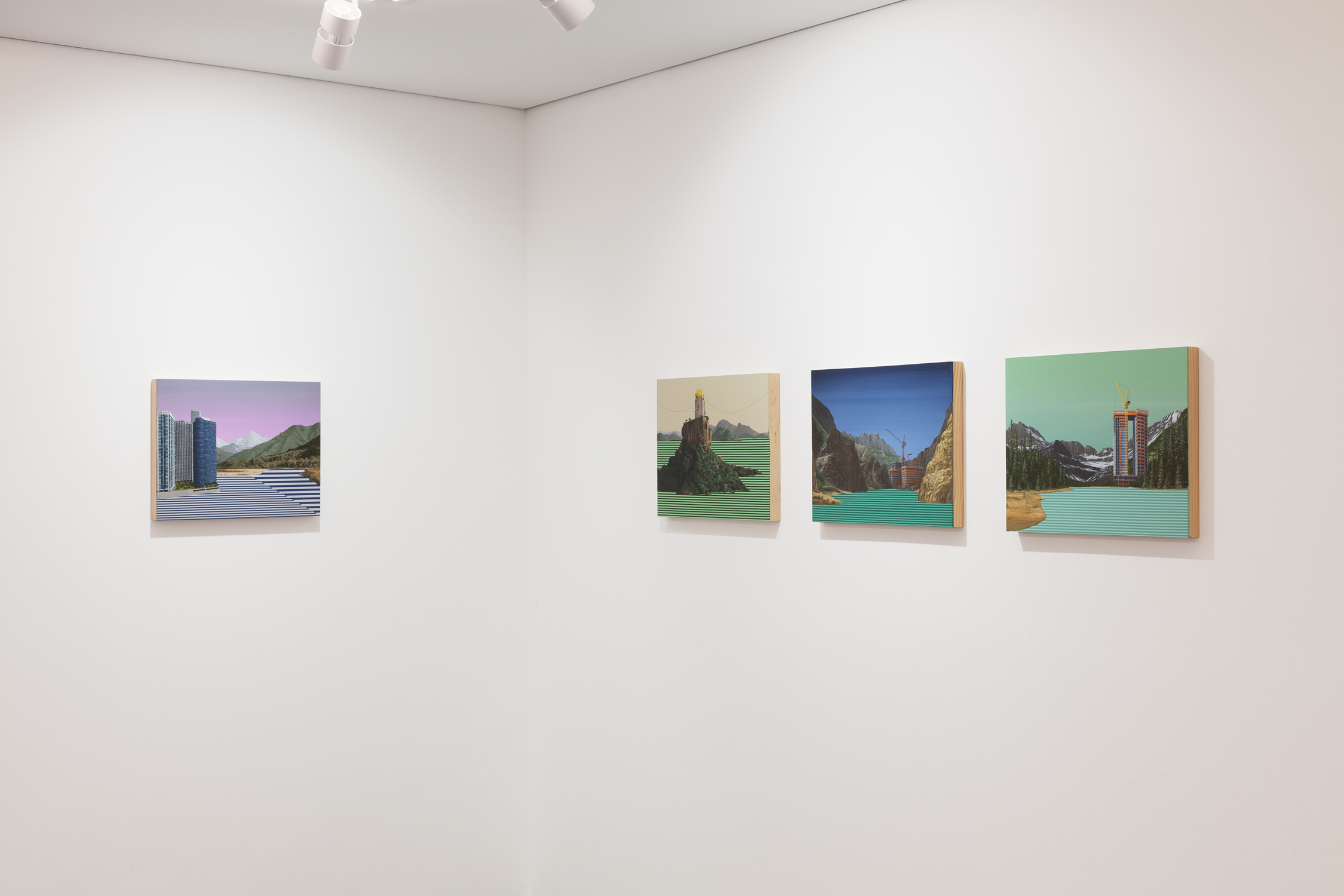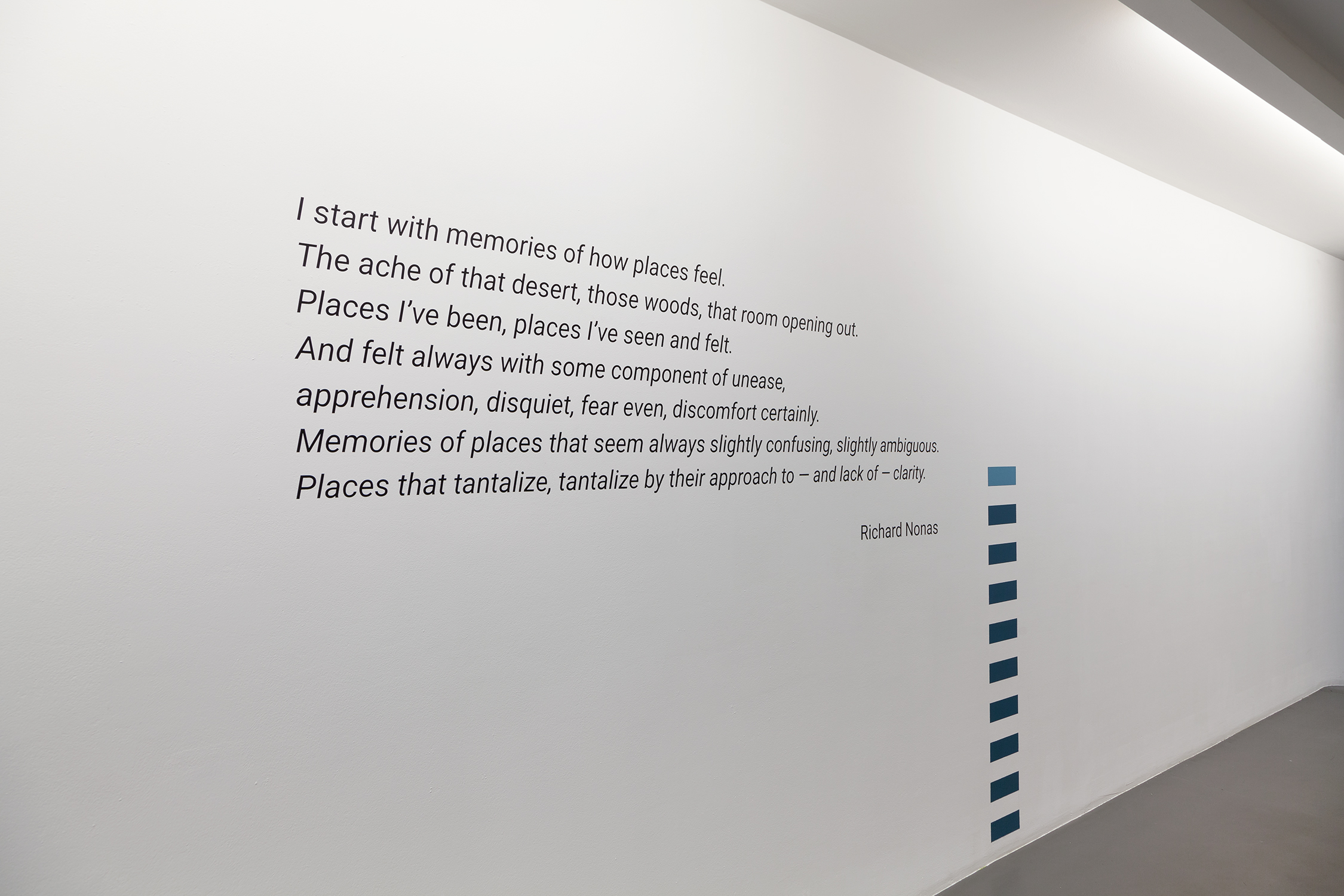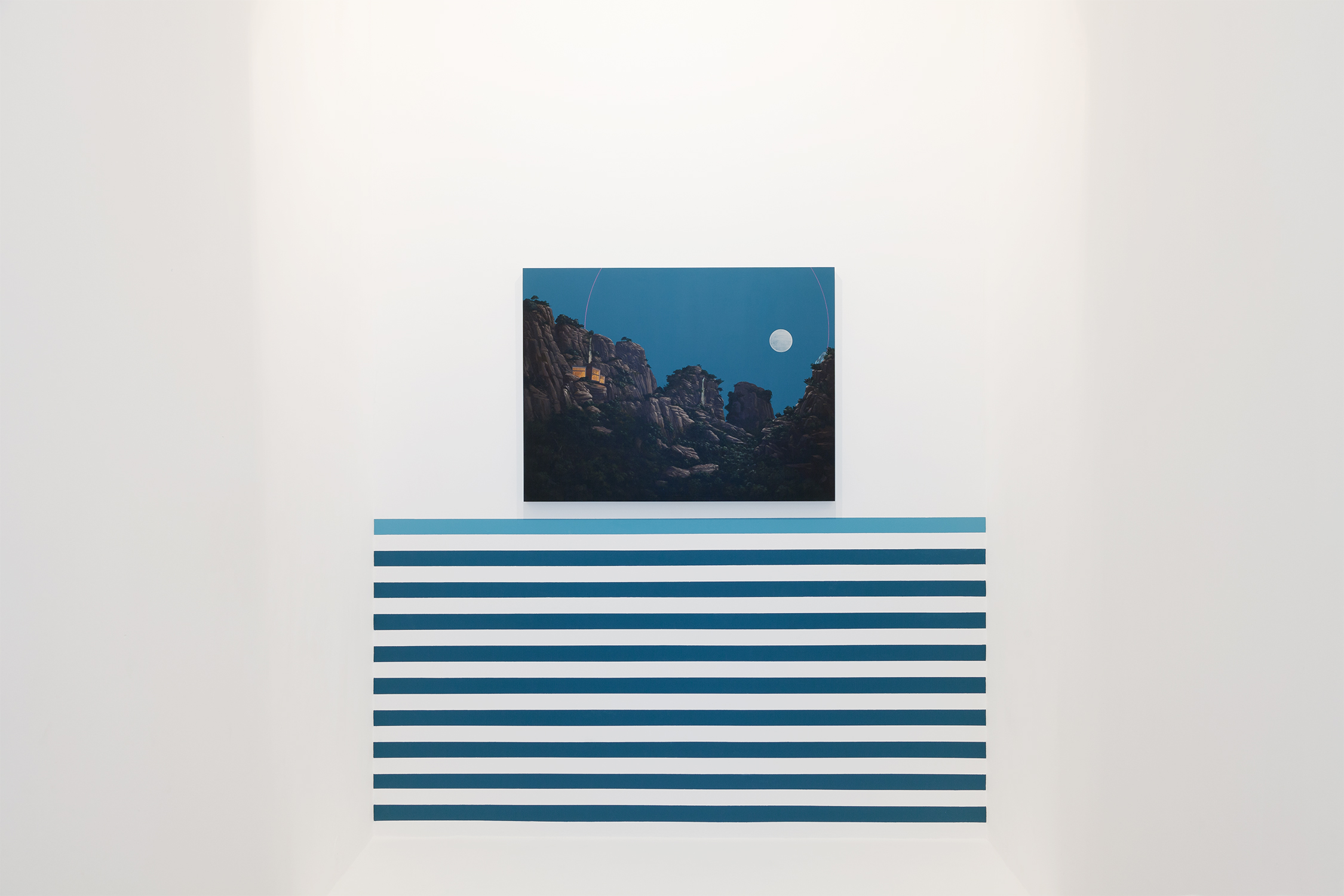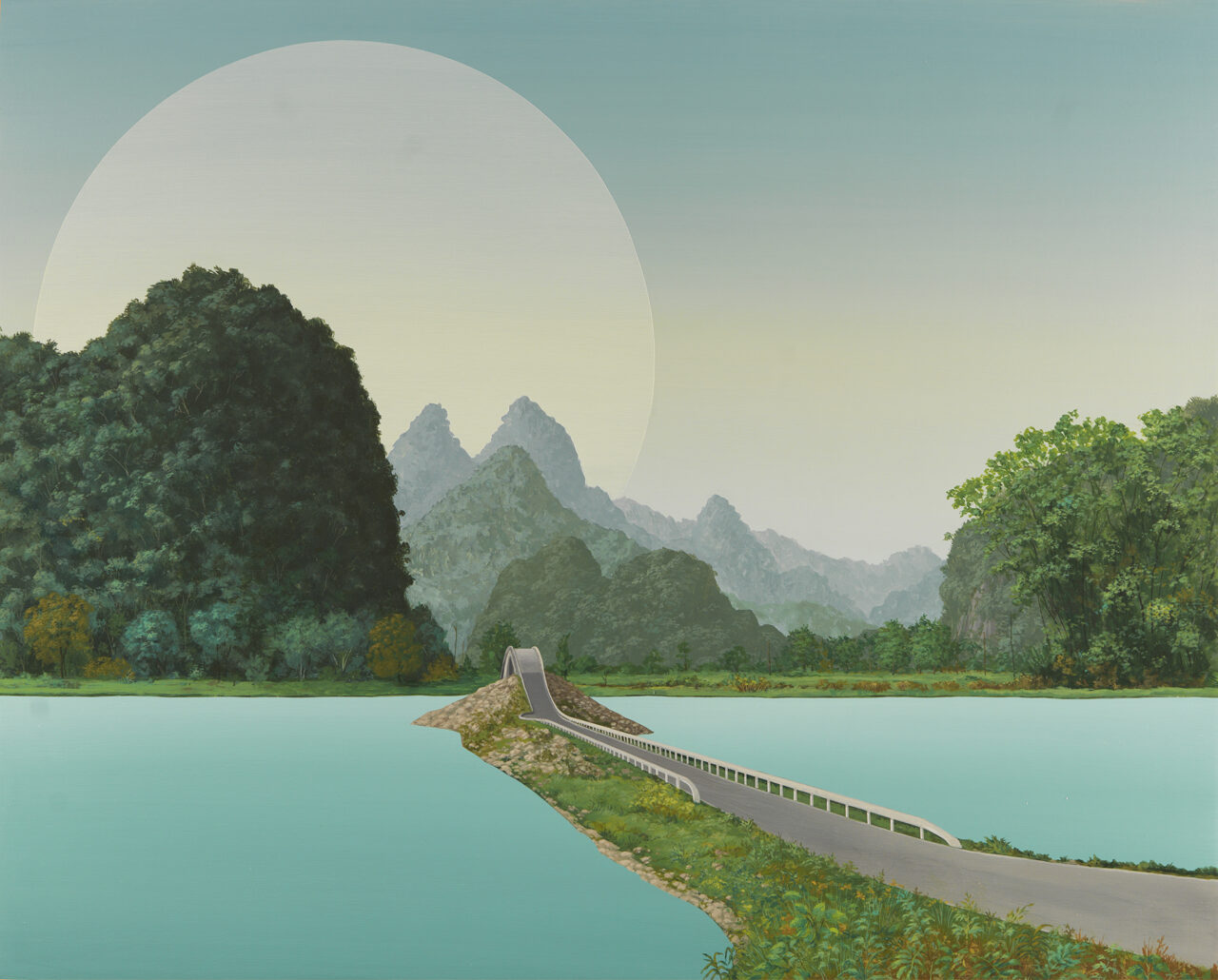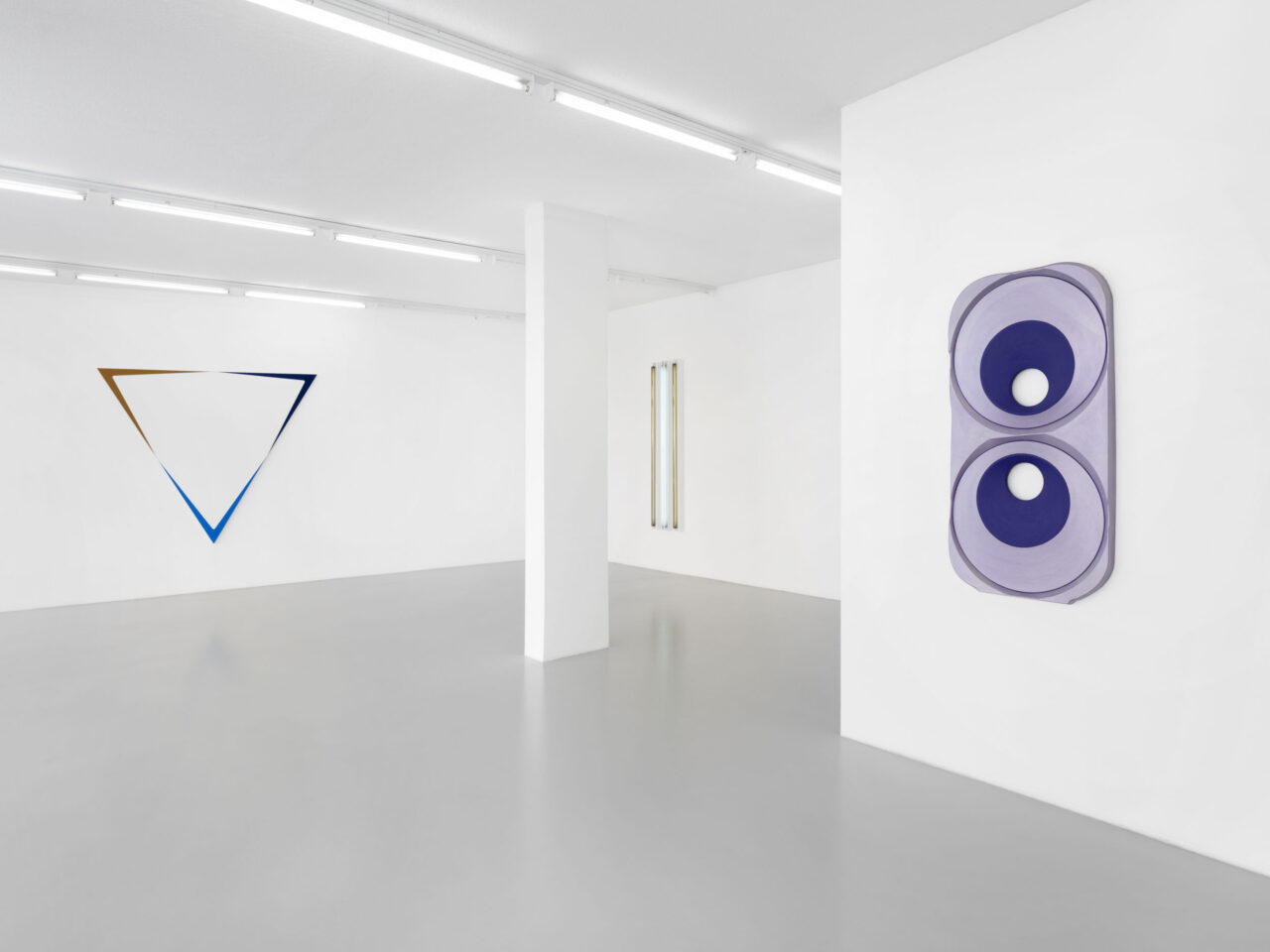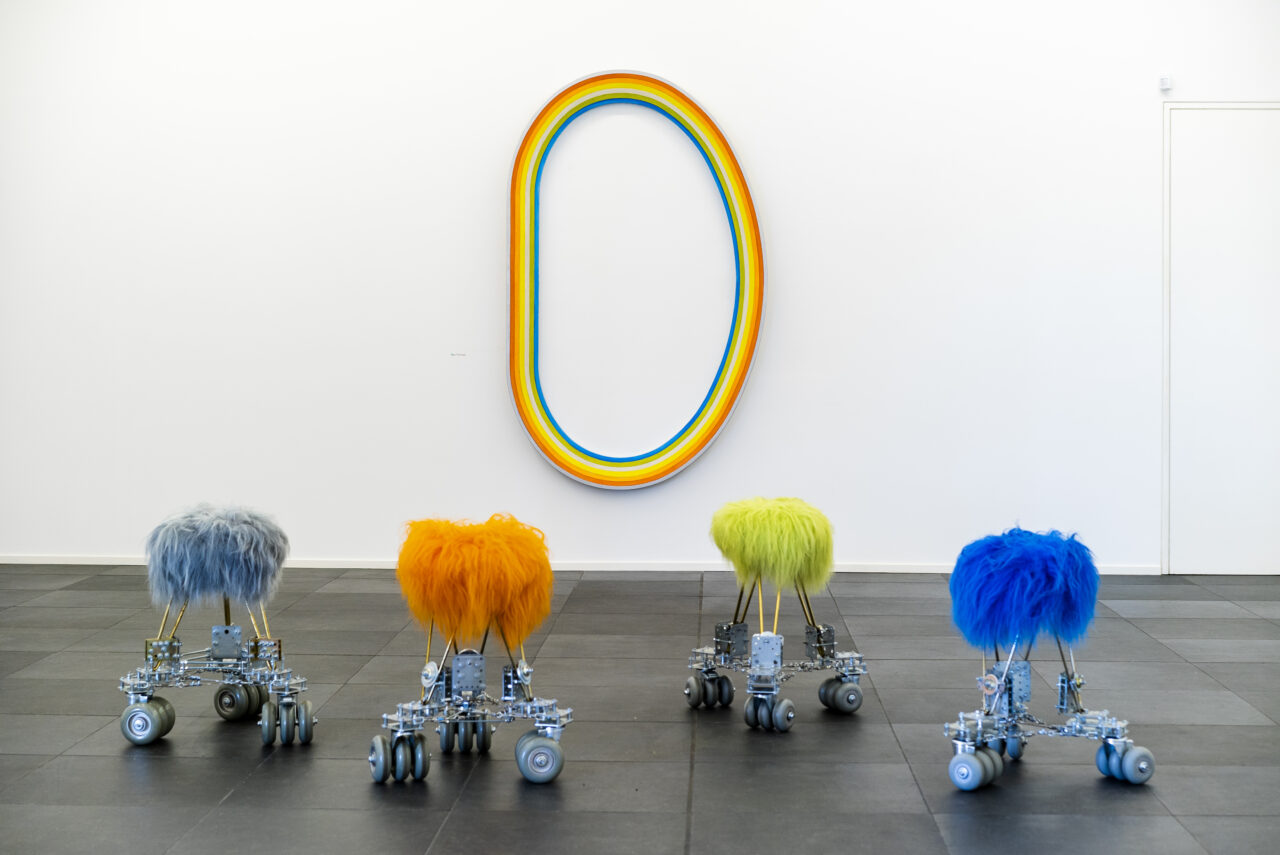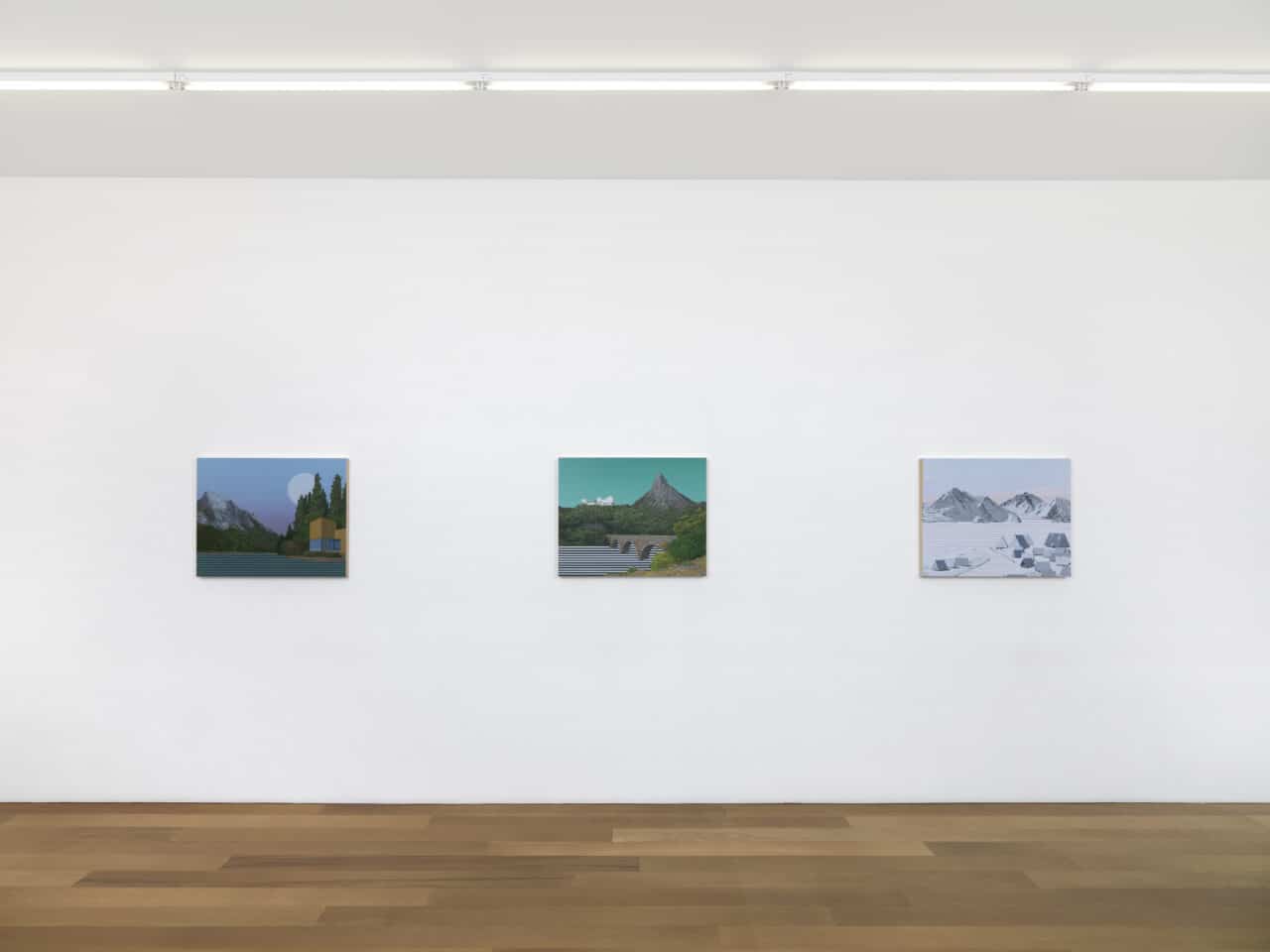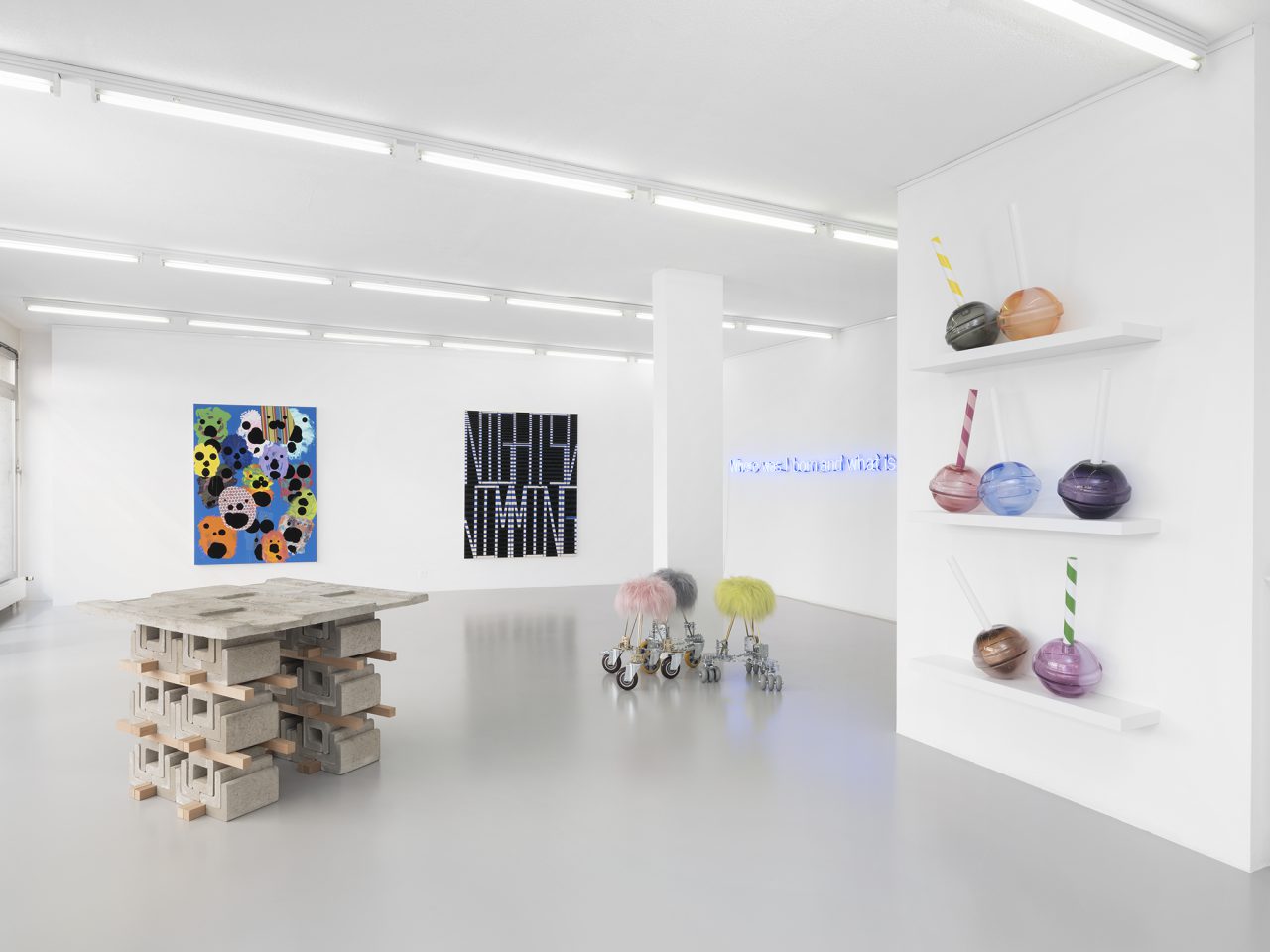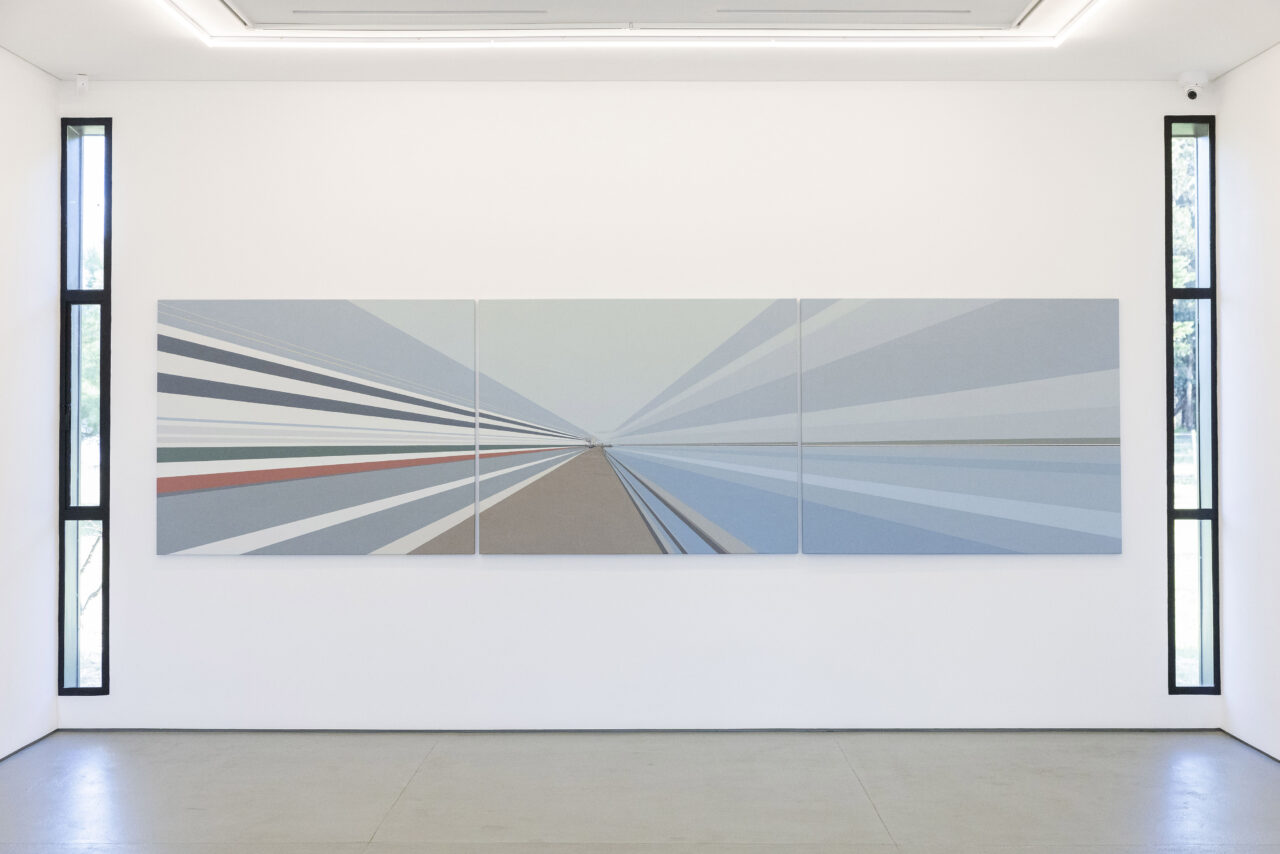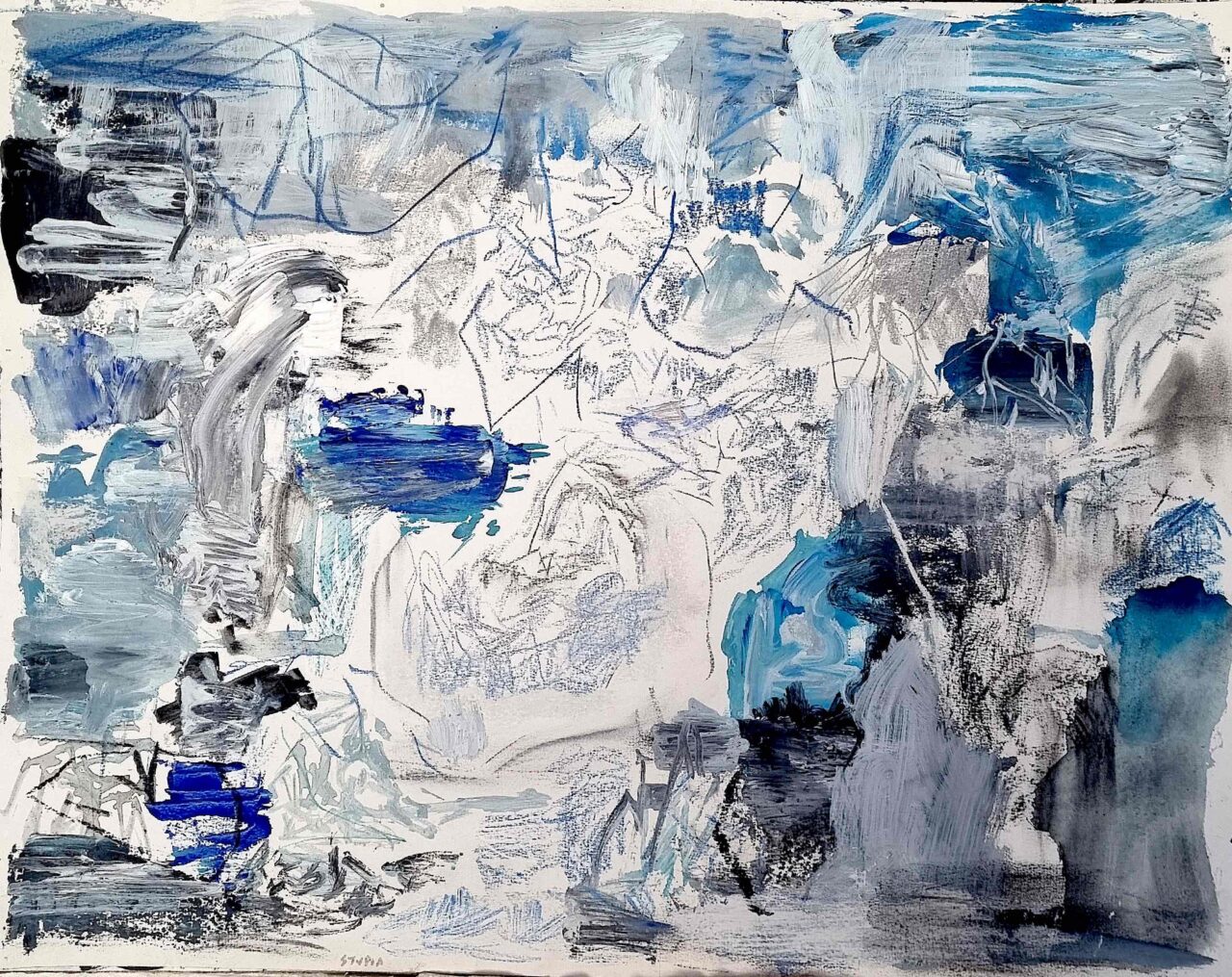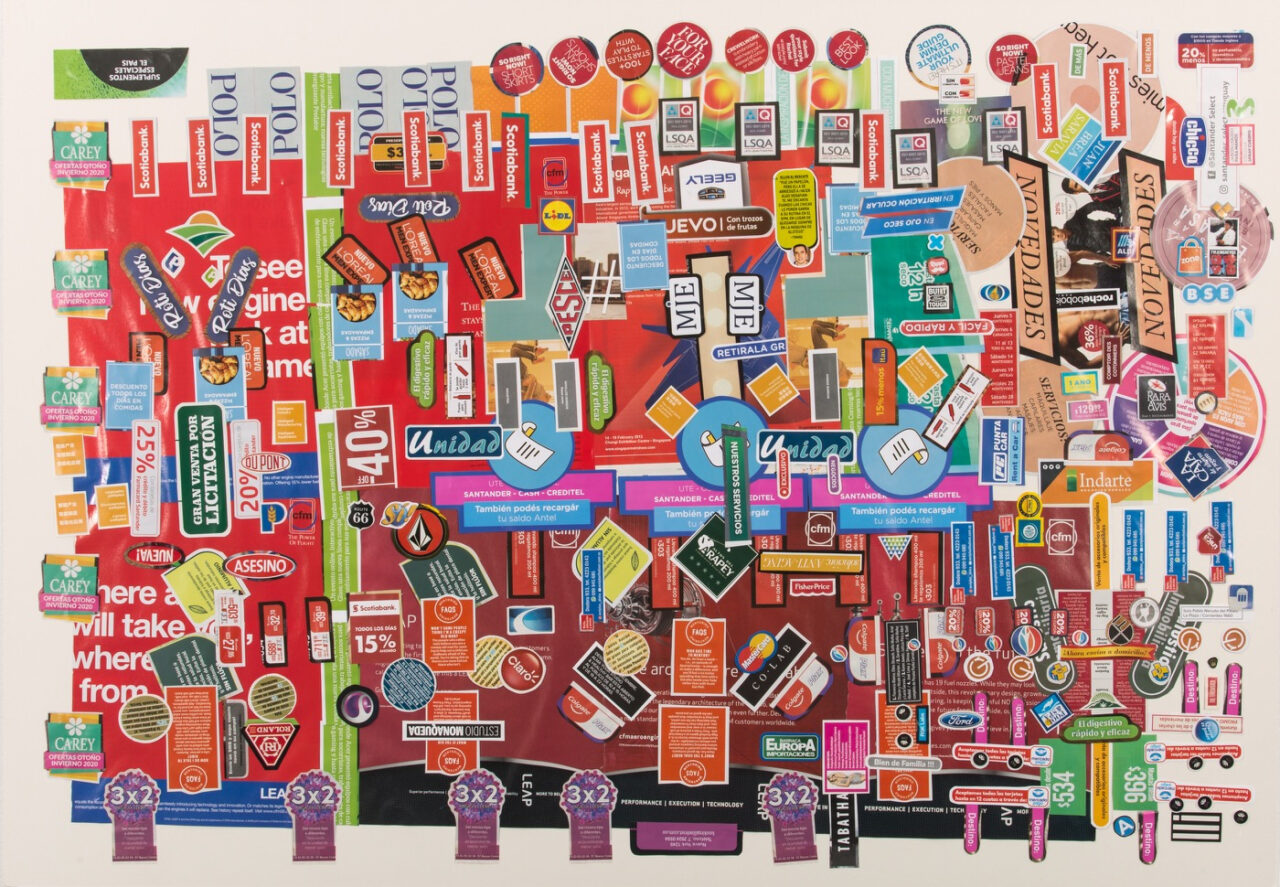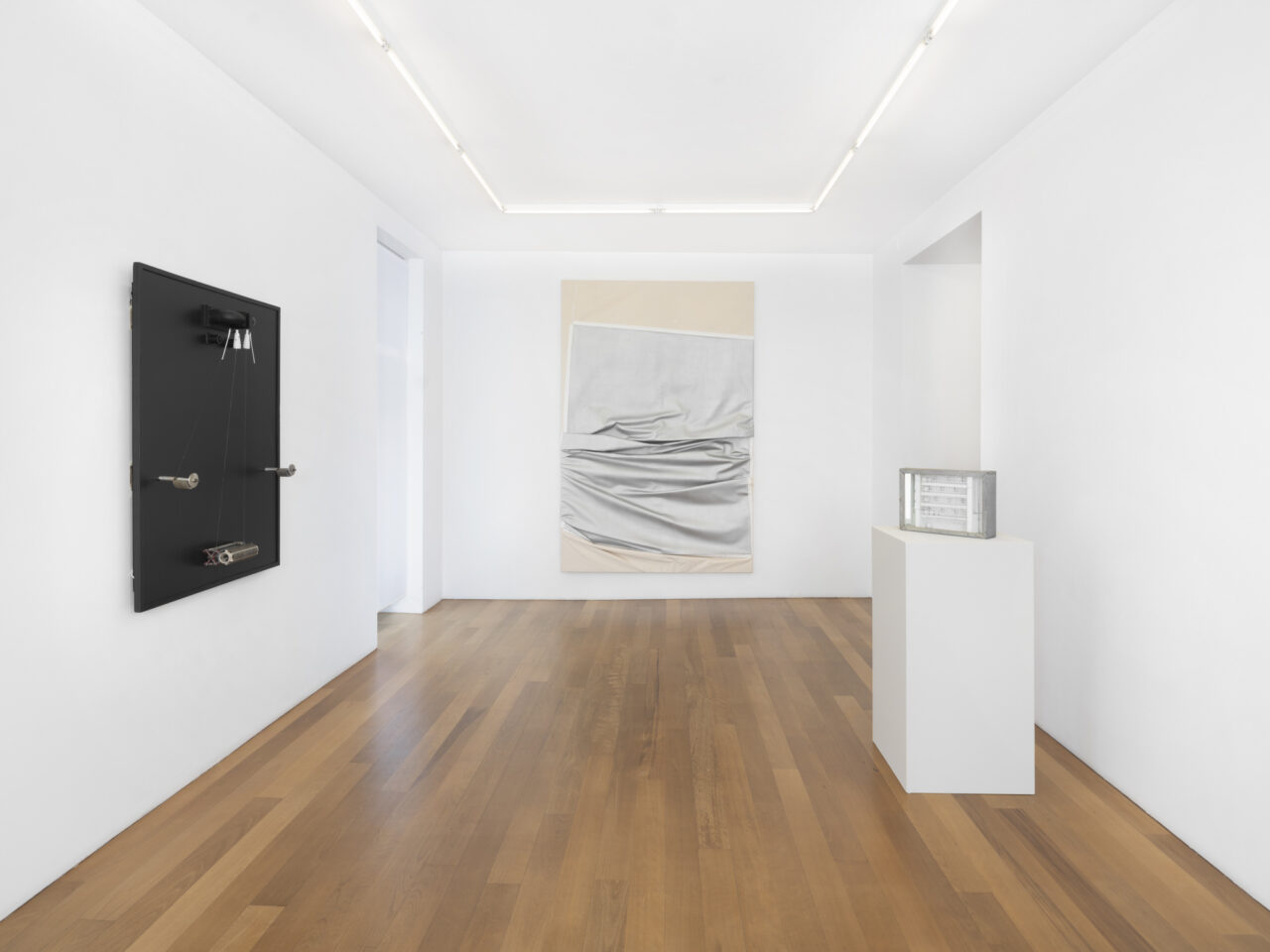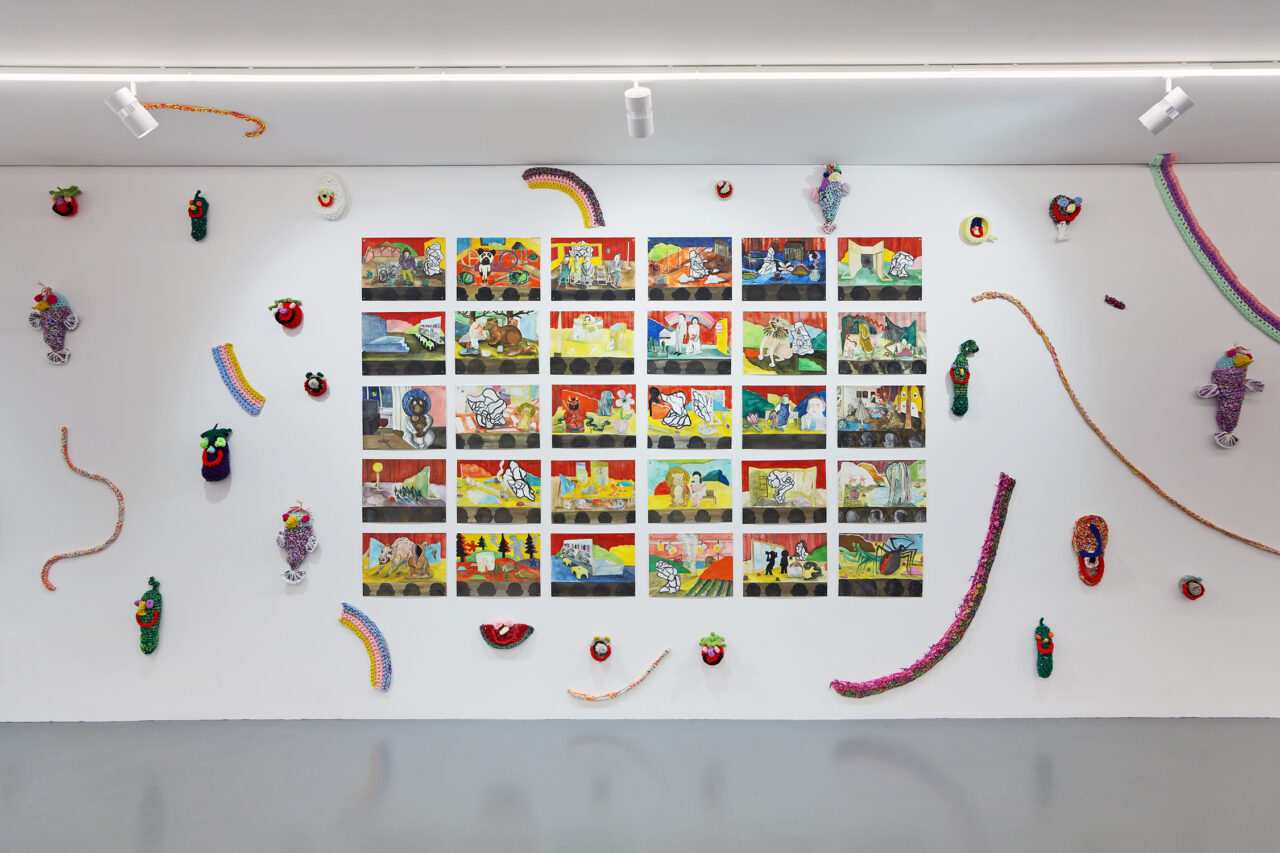Dean Monogenis – Continuous Coast
Dean Monogenis
Continuous Coast
06.11.21 → 15.01.22
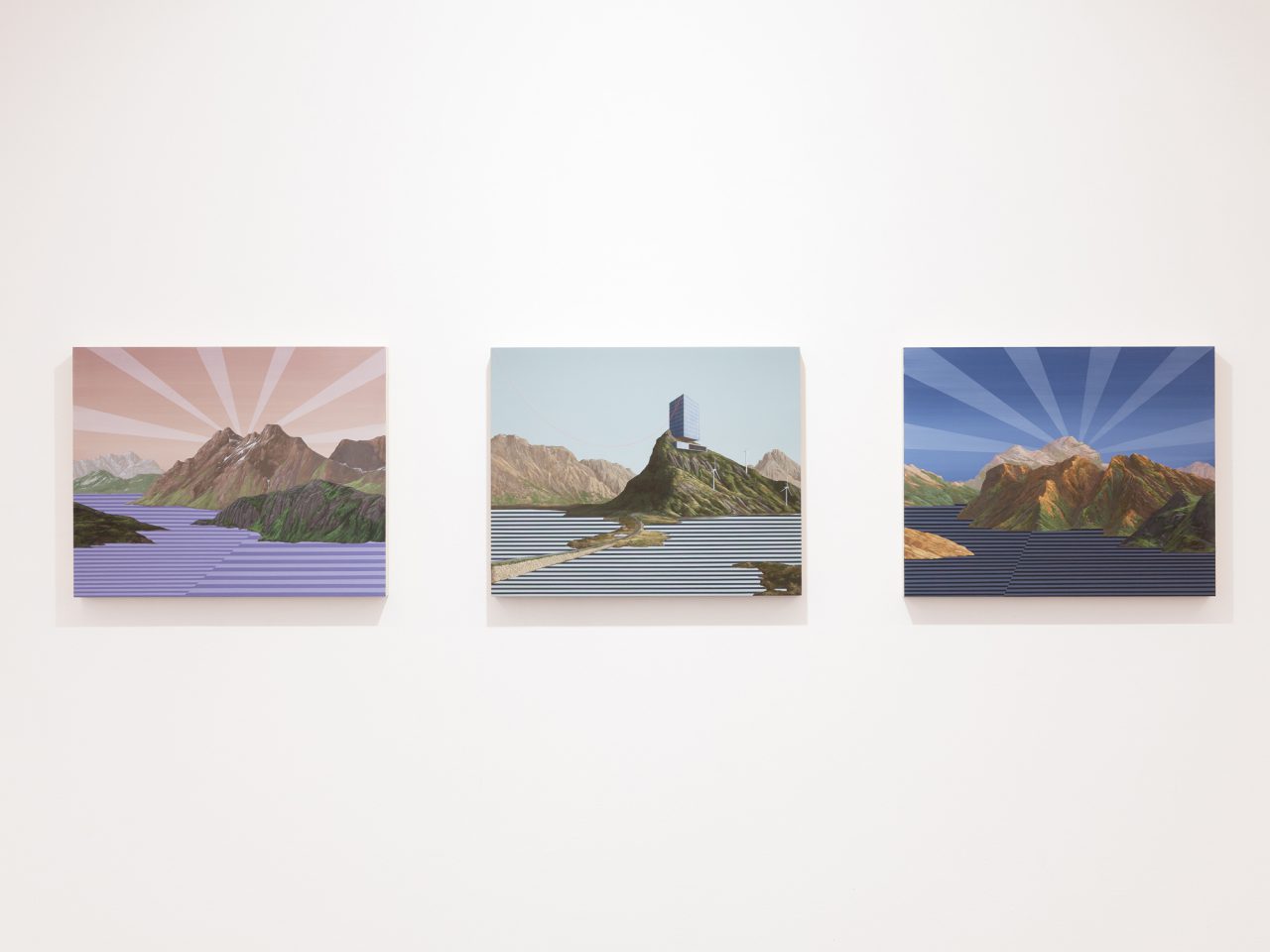
Xippas is happy to present Continuous Coast, a second personal show of Dean Monogenis in our Paris gallery. The exhibition features the artist’s most recent paintings produced during the immobilizing times of Covid. To contradict both physical and mental isolation, these new artworks question the notion of place and advocate connectivity. Springing up from a wasteland created by the impossibility to travel, they invite us on a virtual journey through vivid yet inaccessible places and seek to put the viewer in motion. After all, ‘coast’ is not just a noun but also a verb. It implies a free-flow movement, sometimes even a floating one, – towards a desired destination.
Inspired by Richard Nonas’ poem, this new body of work is rooted in the “memories of how places feel”, crisscrossing sensations with visuals. It draws an imaginary and thus tantalizing coastline, made of fragmented landscapes tied together on a formal and conceptual level. This feeling of togetherness, giving an impression that the artworks are bound into an interconnected whole, a corpus, is ensured not only through the general half-dreamy half-apocalyptic ambience of the paintings, but also through an abstract element – the stripes – ubiquitously present in the composition. Those are summoned to replace water, turning oceans, rivers, waterfalls into a negative space, a conceptual void. In some paintings, they go steadily in parallel lines. In others, like in Slogans Don’t Save Lives, they change their rhythm and create visual ripples, reminding us of the weirdly beautiful borderlines where salt and fresh water meet.
Although the stripe-element has been a frequent participant in Dean Monogenis’ older compositions, making its appearance here and there to counterpoint otherwise figurative paintings, its role has gained in significance in the most recent works. Proportionally speaking, stripes have taken almost as much space as the sky, spreading throughout the landscape. This almost equal-part distribution between painterly and abstract elements creates a wonderful balance in the composition, a subtle sense of equilibrium. The presence of stripes does not disturb nor contradict the figurative component, painted with care and in most delicate details. They are mellifluously woven into the color palette of each painting.
Many things could be inscribed into stripes, stretching their capacity to contain the meaning and leaving space for much liberty: one should read between the lines. Here, they refer not only to water, but also to invisible links or strings betwixt things – and, in this case, in between coastlines –, which function like a narrative glue, connecting distant places and transforming water into a portal or a bridge or airport moving walkways. Stripes, juxtaposed one to another rather tightly, create a mild optical effect and imitate the vibrations of the water surface and its trembly movement. They may also recall partially uploaded 3D textures, as if the image is stalled during the loading process inviting the viewer to wait and to project him- or herself inside the painting, buzzing his or her imagination.
In his opus The Machine in the Garden, Leo Marx underlines the attractiveness of the water sites in landscape painting, explaining that human beings are unconsciously drawn to the water surfaces, as the latter mirrors their image back to them. And even if one cannot recognize oneself in a painted lake or a river, the very presence of the aquatic element embraces, at least conceptually, this possibility. Here, what the viewer may expect to see is a fragmented version of him or herself, an image decomposed by stripes, as if in reference to the general fragmentation of the contemporary subject. One may only speculate on how this fragmentation has been affected by the pandemics and the obligation to stay home. With most of the physical places being out of reach, one possibility that remained was virtual wanderings and adventures.
The word ‘virtual’ is a corner stone in this new series, although it should be taken in a larger sense, as something that maintains a complex relation with the ‘real’. This relation is not necessarily that of opposition, but also of simulation, projection and substitution. These new paintings seek to fill the void, the gap. They compensate the absence. Most of the landscapes reminds us of real places: mountains crowding around lakes, wild forests unfurling their way through the grounds, a road snaking along the coast. Although inspired by existing landmarks, whether it is Norwegian fjords, Greek waterscapes or roundabouts of Lake Mead, these are not reproductions but reinventions of the landscapes. The paintings capture the virtual, the dreamlike.
Although fantastical, Dean Monogenis’ paintings remain ‘real’ – like a dream. And, like a dream, they absorb the incongruous, the poetically symbolic. After all, poetry does happen when the “real” trips over and makes a faux-pas. The strangeness manifests itself through an abandoned building (Asmodea) or eerily colorful tents (Camp Life). It could be light appearing like a delineating geometric entity in its own right (Harmony in my Head) or an aureole-like atomic glow around a building (Two Tides). The poetic dimension, however, doesn’t end there. Some paintings are dipped in the literary. The creation of Tores del Paine was accompanied by the reading of Mount Analog, the surrealist novel by Rene Daumal. Last Resort was enveloped by the spider net of thoughts about the ecologically oriented Monkey Wrench Gang by Edward Abbey. The titles, too, introduce subtle swings of meaning. Some hide references to fictional masterpieces (Halation is a nod to Infinite Jest by David Foster Wallace), others repeat after the newspaper headlines (Slogans Do Not Save Lives or Conquest of Air). They expand the fictionality of the works, blurring the border between existing and only possible. Wrapping the real into surreal.
However strange the landscapes by Dean Monogenis may appear, they, nevertheless, are well rooted in the genuine, the authentic. This is obtained, on the one hand, through reflection upon the idea of what a place is, whether it is a place in particular or any place. On the other hand, it is the feeling the paintings convey. Feeling of the presence. Of the “ache of that desert, those woods, that room opening…” But opening where? And for how long?
Dean Monogenis is an American artist of Greek heritage who lives and works in Brooklyn. His paintings are famous for combining architectural and natural elements, forging utopian vision with a dystopian touch. They feature modernist buildings, colorful scaffoldings, imaginary architect houses in the middle of rocky landscapes taken over by savage vegetation. Since the collapse of the twin towers, Monogenis realised that buildings are meant to live and die, the same way humans do, and they too have stories. It is these stories that the artist tries to bring out by isolating architectural ensembles and by placing them in incongruous surroundings, to make them reveal themselves in a new light.
His oeuvre was part of numerous institutional shows: McNay Art Museum (Saint Antonio), Pavillon de l’Arsenal (Paris), Musée d’art moderne de Saint-Etienne Métropole (Saint-Etienne), Schneider Museum of Art (Ashland), Santa Monica Museum of Art, Bronx Museum of Art (New York), Mykonos Biennale (Mykonos), Angels Gate Cultural Centre (San Pedro), Pace University (New York), Federal Reserve Board (Washington), Hunterdon Art Museum (Clinton, New Jersey), Neuberger Museum (NY), Herter Gallery, (University of Massachusetts, Amherts), Makor-Steinhardt Center (New York), Macedonian Cultural Society (New York), Brooklyn Museum of Art (Brooklyn, New York).
In 2013, Dean Monogenis has received « Artist in the Market Place (AIM) » award, attributed by Bronx Museum of the Arts (Bronx, NY, USA) and in 2014 he was invited to conceive outdoor sculptures for the museum. In 2013 and 2016 he was granted residency in CCA Andratx, Mallorca, Spain.
Exhibition views
-
![Dean Monogenis Xippas Paris 2021 08 web]()
Dean Monogenis, Continuous Coast, Xippas Paris, 2021
-
![Dean Monogenis Xippas Paris 2021 02]()
Dean Monogenis, Continuous Coast, Xippas Paris, 2021
-
![Dean Monogenis Xippas Paris 2021 03]()
Dean Monogenis, Continuous Coast, Xippas Paris, 2021
-
![Dean Monogenis Xippas Paris 2021 04]()
Dean Monogenis, Continuous Coast, Xippas Paris, 2021
-
![Dean Monogenis Xippas Paris 2021 05]()
Dean Monogenis, Continuous Coast, Xippas Paris, 2021
-
![Dean Monogenis Xippas Paris 2021 06]()
Dean Monogenis, Continuous Coast, Xippas Paris, 2021
-
![Dean Monogenis Xippas Paris 2021 07]()
Dean Monogenis, Continuous Coast, Xippas Paris, 2021
-
![Dean Monogenis Xippas Paris 2021 09]()
Dean Monogenis, Continuous Coast, Xippas Paris, 2021
-
![Dean Monogenis Xippas Paris 2021 11]()
Dean Monogenis, Continuous Coast, Xippas Paris, 2021
-
![Dean Monogenis Xippas Paris 2021 13]()
Dean Monogenis, Continuous Coast, Xippas Paris, 2021
-
![Dean Monogenis Xippas Paris 2021 16]()
Dean Monogenis, Continuous Coast, Xippas Paris, 2021
-
![Dean Monogenis Xippas Paris 2021 17]()
Dean Monogenis, Continuous Coast, Xippas Paris, 2021
